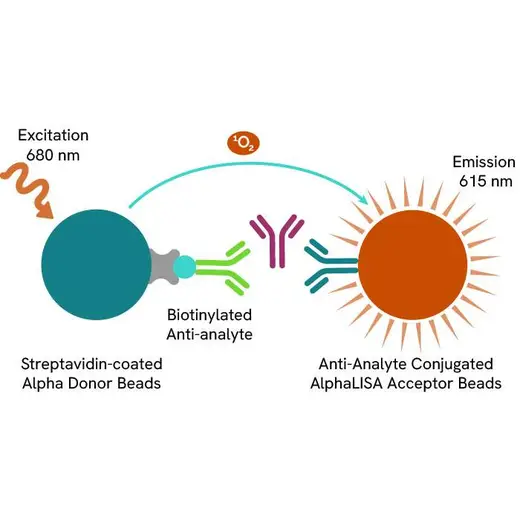
AlphaLISA High Sensitivity HIV p24 Detection Kit, 500 Assay Points


 View All
View All
AlphaLISA High Sensitivity HIV p24 Detection Kit, 500 Assay Points














The AlphaLISA™ Human Immunodeficiency Virus type-1 p24 protein (HIV p24) (high sensitivity) Detection Kit is designed for detection and quantitation of HIV p24 in serum, buffered solution or cell culture medium in a homogeneous (no-wash steps, no separation steps) assay.
For research use only. Not for use in diagnostic procedures. All products to be used in accordance with applicable laws and regulations including without limitation, consumption and disposal requirements under European REACH regulations (EC 1907/2006).
| Feature | Specification |
|---|---|
| Application | Protein Quantification |
| Dynamic Range | 1.8 - 30,000 pg/mL |
| Limit of Detection | 1.8 pg/mL |
| Sample Volume | 5 µL |
The AlphaLISA™ Human Immunodeficiency Virus type-1 p24 protein (HIV p24) (high sensitivity) Detection Kit is designed for detection and quantitation of HIV p24 in serum, buffered solution or cell culture medium in a homogeneous (no-wash steps, no separation steps) assay.
For research use only. Not for use in diagnostic procedures. All products to be used in accordance with applicable laws and regulations including without limitation, consumption and disposal requirements under European REACH regulations (EC 1907/2006).







AlphaLISA High Sensitivity HIV p24 Detection Kit, 500 Assay Points







AlphaLISA High Sensitivity HIV p24 Detection Kit, 500 Assay Points







Product information
Overview
Formats:
- Our 500 assay point kit allows you to run 500 wells in 96-well or 384-well format, using a 50 µL reaction volume (5 µL of sample).
- Our 5,000 assay point kit allows you to run 5,000 wells in 96-well or 384-well format, using a 50 µL reaction volume (5 µL of sample).
Features:
- No-wash steps, no separation steps
- ELISA alternative technology
- Sensitive detection
- Broad sample compatibility
- Small sample volume
- Results in less than 3 hours
- Half the time of an ELISA assay
Immunodeficiency Virus (HIV) p24 is the 231 amino acid phosphorylated protein of the capsid forming the conical core of the virus that encapsulates the genomic RNA-nucleocapsid complex. p24 is a cleavage product of the p55 Gag polyprotein by viral proteases. HIV p24 and its 55 kDa precursor play a crucial role in the assembly, maturation, and disassembly of HIV. p24 can often be detected two weeks after infection. Subsequently, p24 antibody is produced and complexes with soluble p24 antigen, rendering it undetectable without first dissociating the antibody-antigen complex. Free antigen reappears later in the course of the illness as p24 antibody levels decline. p24 is frequently used for HIV detection in blood, serum samples, and other bodily fluids in acute HIV seroconversion, in neonatal infection, and for monitoring of responses to antiviral drug therapy.
AlphaLISA technology allows the detection of molecules of interest in a no-wash, highly sensitive, quantitative assay. In an AlphaLISA assay, a biotinylated anti-analyte antibody binds to the Streptavidin-coated Donor beads while another anti-analyte antibody is conjugated to AlphaLISA Acceptor beads. In the presence of the analyte, the beads come into close proximity. The excitation of the Donor beads causes the release of singlet oxygen molecules that triggers a cascade of energy transfer in the Acceptor beads, resulting in a sharp peak of light emission at 615 nm.
Specifications
| Application |
Protein Quantification
|
|---|---|
| Automation Compatible |
Yes
|
| Brand |
AlphaLISA
|
| Detection Modality |
Alpha
|
| Dynamic Range |
1.8 - 30,000 pg/mL
|
| Limit of Detection |
1.8 pg/mL
|
| Product Group |
Kit
|
| Sample Volume |
5 µL
|
| Shipping Conditions |
Shipped in Blue Ice
|
| Target |
p24
|
| Target Class |
Biologics
|
| Technology |
Alpha
|
| Therapeutic Area |
Virology
|
| Unit Size |
500 Assay Points
|
Image gallery






AlphaLISA High Sensitivity HIV p24 Detection Kit, 500 Assay Points






AlphaLISA High Sensitivity HIV p24 Detection Kit, 500 Assay Points






Video gallery

AlphaLISA High Sensitivity HIV p24 Detection Kit, 500 Assay Points

AlphaLISA High Sensitivity HIV p24 Detection Kit, 500 Assay Points

Citations
Resources
Are you looking for resources, click on the resource type to explore further.
The main vectors of gene therapy in research are viruses. The most popular tool for gene delivery is a genetically modified...
Chimeric antigen receptor (CAR) T-cell therapy has transformed the field of immuno-oncology providing a novel approach to treating...


How can we help you?
We are here to answer your questions.






























